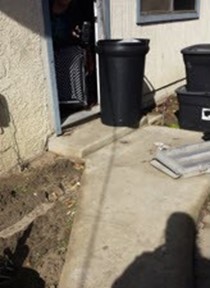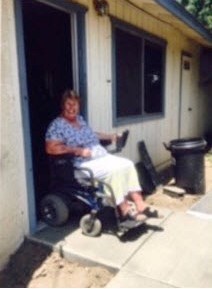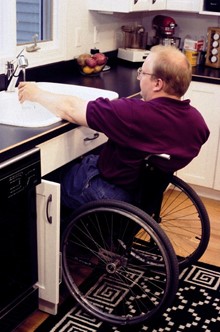The Home Usability Network: A New Method To Improve Community Participation
This information is available in PDF format upon request.
Why It Matters: Participation Begins at Home
People with disabilities want to participate in their communities, but sometimes their environment makes it hard to get out and about. This environment includes a person’s home. If you have trouble using your bathroom, kitchen or bedroom, you may be exhausted before you even leave home to take part in activities that are important to you.
A usable home is key to living independently and participating in society. Home is the springboard for community participation, whether that means going to a doctor’s office, meeting friends at a restaurant, or volunteering at the local animal shelter.
In this research project, Centers for Independent Living (CILs) and people with disabilities use a new method to improve their homes and their quality of living: The Home Usability Network (HUN).
What’s the Difference? Accessible and Usable Homes
“Accessible” describes the physical environment based on regulations outlined in the Americans with Disabilities Act Accessibility Guidelines and section 504 of the Rehabilitation Act. A space is either accessible or not. For example, a door’s accessibility can be measured with a measuring tape; either it is 32” across or not.
“Usable,” on the other hand, describes how a person interacts with his or her environment. Spaces can be usable for some people and not others. For example, an accessible bathroom may not be usable for a person of short stature.
The HUN website supports people working together to implement a network in their community.
In this research project, we focus on solving home usability problems that are unique to each person’s own situation. Problems may include:
- Entering and exiting your home
- Preparing meals in your kitchen
- Using your bathroom’s toilet and shower or tub
- Using your bedroom for dressing and going to bed
- Using storage places like closets and cupboards
- Cleaning and tidying up


How the Home Usability Network (HUN) Works
The Home Usability Network is a group of individuals and organizations who value independent living and full participation for people with disabilities.
Who Is in the HUN? The key players are Centers for Independent Living, which manage the HUNs, and the people with disabilities whom they serve, their consumers. A wide variety of other community organizations and local professionals can be invited to join the HUN. Each member brings special expertise to help create home usability solutions.
The HUN should begin by recruiting members with skills in these areas:
- Funding
- Trade and labor (plumbing, carpentry, electrical, etc.)
- Assistive technology (AT)
- Fair housing
- Independent living (IL) skills training
Other community members can also important to the HUN’s work: peers and other consumers, friends and family, landlords/property managers, policymakers, occupational therapists, housekeeping services, and other CIL staff members.
What the HUN Does: The consumer identifies a usability problem in her home, then completes a home usability plan working with staff at her local CIL. The CIL staff member connects her with the right people in the HUN to address her unique issue. Together, this network of individuals completes the home usability plan.
Testing the HUN: Before and After
For this research, we’re working with CILs in three cities to test how well a HUN works: accessABILITY in Indianapolis, In.; disABILITY LINK in Tucker, Ga.; and Resources for Independence Central Valley (RICV) in Fresno, Ca.
In the first year of this test, the three HUNs have helped consumers solve both small and large usability problems.
- In one home, faucets were switched from hard-to-use handles to easy- to-use levers.
- In another home, grab bars were installed in the tub to increase the consumer’s safety.
- At one wheelchair user’s home, an entrance step was replaced with an accessible entry and wider sidewalk. .
For Mary Wheeler in Fresno, that new entrance and sidewalk mean she can participate more freely in life. She feels more independent and less concerned about being a burden to others. Mary commented on the change:
“I love that I can go in and out of my front door. It means it’s easier for me to get out and spend time with my grandkids in the front yard. It’s a real gift from God.”
Sometimes improvements were made outside the home, such as creating curb cuts. People want to go beyond their home to participate, so the outdoor environment also plays a part in home usability.
A New Tool for CILs: How the HUN Adds Resources
Most CILs already help consumers add ramps to their homes for accessibility, so a Home Usability Network might not be needed for that service.
But fixing smaller usability issues can also make a big difference. Margo Waters, a CIL staff project facilitator at disABILITY LINK, said:
“The project has really helped bring awareness to usability issues. Sometimes it’s the little things, like a shower chair, that can make someone’s life easier.
“Working with this project has helped us identify different organizations and resources in the community. It has made us realize that we need to make more time to maintain our resource lists.”
And Morgan Daly from accessABILITY said that working with the HUN has given the CIL staff a new methodforbuildingresourcesfor all consumers:
“Now when we do intake we’re gathering information about a consumer’s personal network in the community.”
 Next Steps
Next Steps
Our goal is to empower people with disabilities to use their homes more fully. We think this will also increase their community participation. We will evaluate the experiences each CIL had using the HUN with their consumers, then share the HUN strategy with more CILs across the United States.
Project Investigators At the University of Montana Rural Institute: Craig Ravesloot, PhD; Lillie Greiman, MA and Andrew Myers, MA
The contents of this factsheet were developed under a grant from the National Institute on Disability, Independent Living, and Rehabilitation Research (NIDILRR grant number 90RT5015). NIDILRR is a Center within the Administration for Community Living (ACL), Department of Health and Human Services (HHS). These contents do not necessarily represent the policy of NIDILRR, ACL, or HHS, and you should not assume endorsement by the Federal Government.